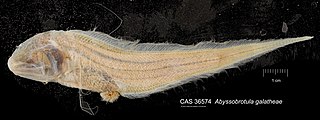 W
WAbyssobrotula galatheae, is a species of cusk eel in the family Ophidiidae. It is the deepest-living fish known; one specimen, trawled from a depth of 8,370 m (27,460 ft) in the Puerto Rico Trench in 1970, holds the record for the deepest fish ever captured. Although generally recognized, some have suggested that the record-breaking individual might have been caught with a non-closing net and therefore perhaps caught shallower.
 W
WThe amber darter is a small, endangered species of freshwater ray-finned fish, a darter from the subfamily Etheostomatinae, part of the family Percidae, which also contains the perches, ruffes and pikeperches. It is native to the Conasauga River and Etowah River in Georgia and Tennessee in the United States. It typically inhabits riffle areas over gravel and sand bottoms, hiding in aquatic vegetation when present. It feeds on small invertebrates and probably breeds between late fall and early spring. It is an uncommon fish with a small range and the International Union for Conservation of Nature has classified its conservation status as being "endangered".
 W
WAmblyeleotris wheeleri, the Gorgeous prawn-goby, is a species of goby native to tropical reefs of the Indian Ocean to the western Pacific Ocean. It can be found at depths of from 5 to 40 metres though is usually does not occur deeper than 15 metres (49 ft). It is a commensal with alpheid shrimps, most often being found in association with Alpheus ochrostriatus. This species can reach a length of 10 centimetres (3.9 in) SL. It can also be found in the aquarium trade. The specific name honours the English ichthyologist Alwynne Cooper Wheeler (1929-2005), who was curator of Fishes at the British Museum, "for his help over the years, particularly with the authors’ study of prawn-associated gobies of the Seychelles".
 W
WThe Arabian himri is a species of ray-finned fish in the genus Carasobarbus. It is endemic to Saudi Arabia in wadis in the Hijaz Mountains which either drain into the Red Sea or inland.
 W
WThe blackcheek moray eel or masked moray is a species of marine fish in the family Muraenidae.
 W
WThe bleeding wrasse is a species of marine ray-finned fish from the family Labridae, the wrasses. It is found in reefs in the eastern central Pacific Ocean.
 W
WCentropyge multispinis, known commonly as the yellowfin- or moonbeam angelfish, is a marine fish native to the Indian Ocean.
 W
WCyprinus yilongensis is an extinct species of ray-finned fish in the family Cyprinidae. It was found only in Yilong Lake, Yunnan, China. It was last seen before 1981, when the lake was drained for 20 days, presumably causing the species' extermination.
 W
WDascyllus flavicaudus, common name yellowtail dascyllus, is a Damselfish belonging to the family Pomacentridae.
 W
WThe Hadramaut himri is a species of ray-finned fish in the genus Carasobarbus, it is endemic to Yemen where it occurs in Wadi Hadramaut, and possibly Wadi Maran.
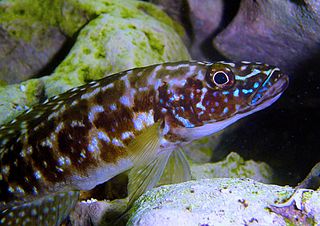 W
WLepidiolamprologus kendalli is a species of cichlid endemic to Lake Tanganyika preferring rocky areas. This carnivorous species preys upon fish. This species can reach a length of 18 centimetres (7.1 in) TL. It can also be found in the aquarium trade. The specific name honours the American fish ecologist Robert L. Kendall, who collected the type.
 W
WThe long green wrasse, Pseudojuloides elongatus, is a species of wrasse native to coastal waters from Australia to New Zealand and Norfolk Island. This species occurs to depths around 25 m (82 ft) in weedy areas on reefs. It can reach 12.6 cm (5.0 in) in standard length. This species is also found the aquarium trade.
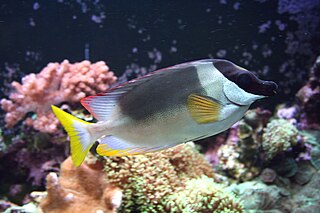 W
WThe magnificent rabbitfish is a rabbitfish from the eastern Indian Ocean. It occasionally makes its way into the aquarium trade. It grows to a length of 24 cm.
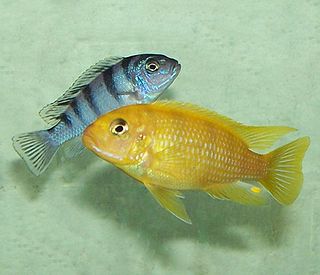 W
WMaylandia lombardoi, is a 13 centimetres (5.1 in) long freshwater fish from the family Cichlidae. This species is popular in the aquarium hobby where it is sold under a variety of common names including: lombardoi mbuna, kenyi mbuna or kennyi mbuna or kenyi cichlid. This species is sometimes seen in the genus Metriaclima owing to a dispute in which a minority of cichlid researchers do not consider Maylandia valid (see Maylandia for discussion. The specific name honours the exotic fish dealer John Lombardo.
 W
WThe Ozark bass is a species of freshwater fish in the sunfish family (Centrarchidae) of order Perciformes. It is native only to the White River, Sac River, James River, and Pomme de Terre river drainages of Missouri and Arkansas.
 W
WThe pale toadfish is a fathead sculpin of the family Psychrolutidae, found on the continental shelf around New Zealand, between 250 and 1,000 metres deep. It is up to 30 cm long.
 W
WPelvicachromis sacrimontis is a freshwater fish of the cichlid family known only from a small area of southeastern Nigeria.Currently Fishbase considers this binomial to be a junior synonym of P. pulcher and, it was also known as Pelvicachromis camerunensis, P. pulcher "form B" or P. sp. aff. pulcher but some authorities now consider it to be a vaild species. It is occasionally available in the tropical fish trade as "giant krib" and there are three colour morphs – red, green and yellow.
 W
WAmblyeleotris aurora, the pinkbar goby, is a species of goby native to reefs of the western Indian Ocean at depths of from 5 to 40 metres though usually not deeper than 10 metres (33 ft). It is commensal with the shrimp Alpheus randalli. This species can reach a length of 11 centimetres (4.3 in) TL. It can also be found in the aquarium trade.
 W
WRhinopias eschmeyeri is a scorpionfish from the Indo-West Pacific. It grows to an average size of 16.6 cm in length. Common names in English are Eschmeyer's scorpionfish and Paddle-flap scorpionfish. It occasionally makes its way into the aquarium trade. Although some have raised questions as to whether R. eschmeyeri is a morphological variant of Rhinopias frondosa rather than a separate species, a 2006 study by Motomura and Johnson confirmed the species' existence and distinguished it from other members of the genus Rhinopias.
 W
WThe royal tetra is a species of characin endemic to Brazil, where it is found in the Aripuanã River. It is also kept as an aquarium fish. It is the sole member of its genus.
 W
Wthe Two Spot Goby, or Crab-eyed Goby, is a species of goby native to the Western Pacific Ocean where they can be found in areas of sand, silt in lagoons, or coastal bays with nearby cover such as rubble, coral, or leaf litter. They can be found at depths of from 1 to 30 metres. This species can reach a length of 10 centimetres (3.9 in) SL. It can also be found in the aquarium trade. It is currently the only known member of its genus.
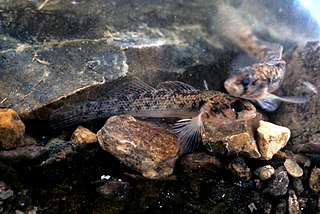 W
WThe striated darter is a species of freshwater ray-finned fish, a darter from the subfamily Etheostomatinae, part of the family Percidae, which also contains the perches, ruffes and pikeperches. It is endemic to the eastern United States. It occurs in the Duck River system in Tennessee. It inhabits rocky pools in creeks. This species can reach a length of 5.6 centimetres (2.2 in) TL though most only reach about 3.8 centimetres (1.5 in).
 W
WThe striped grunter is a species of freshwater ray-finned fish, a grunter from the family Terapontidae. It is found only in the Bewani Mountains in the headwaters of the Pual River system in Papua New Guinea and the upper Sermowai River, Western new Guinea, Indonesia. It is found in igh altitude, fast flowing mountains streams. The males guard and fan the eggs.
 W
WCtenogobiops tangaroai, the Tangaroan shrimp-goby, is a species of goby of the family Gobiidae, native to the reefs of the Pacific Ocean where it can be found in fine-grained sand patches at depths of from 4 to 40 metres. This species is commensal with alpheid shrimps, with a fish and shrimp sharing a burrow. This species can reach a length of 6 centimetres (2.4 in) TL. It can also be found in the aquarium trade.
 W
WThe Thai whiting, Sillago intermedius, is a species of coastal marine fish of the smelt-whiting family Sillaginidae. The Thai whiting ranges from the west coast of India to the Gulf of Thailand in the east, inhabiting silty substrates in shallow waters. First identified in 1977 from a specimen found in a fish market, the species has had little research performed on its biology, and is frequently misidentified as Sillago sihama or Sillago maculata Thai whiting are commonly caught by fishermen throughout their range and are marketed fresh locally.
 W
WTropheus polli is a species of cichlid endemic to Lake Tanganyika, where it is only known from the central eastern portion of the coast in areas with rocky substrates. This species can reach a total length of 16.5 cm (6.5 in). It can also be found in the aquarium trade. The specific name honours the ichthyologist Max Poll. It is considered by some authorities to be a synonym of Tropheus annectens.